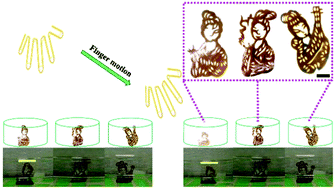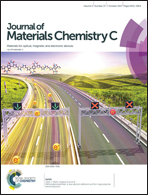Pristine graphene oxide film-based contactless actuators driven by electrostatic forces†
Abstract
Graphene oxide (GO)-based actuators provide a material-centered mechanism to enable a broad range of promising applications, especially in artificial muscles, sensors, switches, and energy harvesting devices. However, the current fabrication methods of such actuators require the complicated synthesis of GO-based composites that inevitably break the intrinsic structure of GO. Moreover, the obtained actuators are commonly driven by a strong external stimulus (light, moisture, or electricity) with unavoidable direct contact, which results in the decomposition of the GO-based composites, and thus reduces the device lifetime. To address the aforementioned challenges and limitations, we demonstrate a simple and generic electrostatic actuation principle for the design and fabrication of pristine GO film-based contactless actuators with a fast actuation response, good reversible actuation, and high stability. The resulting GO film-based actuators can be driven easily by almost all commonly charged objects. Two applications are demonstrated, one is a smart “radar” made by a 3 × 3 GO film strip array for tracking the motion of objects, and the other one is GO film-based “dancers” obtained from Chinese paper-cuts. The presented contactless actuation principle and the simple fabrication process open a new avenue for the design and development of GO-based actuators, which can be easily extended to the fabrication of other smart devices for motion detection or energy harvesting.



 Please wait while we load your content...
Please wait while we load your content...